ASUS N61Jv-X2: Optimus GT325M Meets Arrandale
by Jarred Walton on March 13, 2010 10:00 PM ESTASUS N61Jv-X2 General Performance
The N61Jv is like the Dell Inspiron 1564; we have many similar components and a good point of comparison. We have the same 4GB of DDR3, a slightly slower Core i5-430M processor, and a different GPU. General performance should be more than fast enough for all but the most demanding users; if you're one of those, consider moving to an i7-based notebook instead (with an accompanying loss in battery life). Here's the quick recap of our N61Jv configuration.
| ASUS N61Jv-X2 Testbed | |
| Processor | Intel Core i5 520M (2x2.4GHz, 32nm, 3MB L3, Turbo to 2.83GHz, 35W) |
| Memory | 2x2GB DDR3-1066 (Kingston ASU1333D3S9DR8/2G) |
| Graphics | NVIDIA GeForce GT325M 1GB 128-bit Optimus 48 SPs (CUDA Cores) @ 450/990/1400MHz GPU/SPs/RAM Intel HD Graphics IGP |
| Display | 16.0" LED Glossy 16:9 768p (1366x768) (HannStar HSD160PHW1) |
| Hard Drive(s) | 500GB 7200RPM 16MB HDD (Seagate Momentus 7200.4 ST9500420AS) |
| Optical Drive | 8x DVDR SuperMulti (LG GT30N) |
| Battery | 6-Cell, 10.8V, 4400mAh, 48Wh battery "Up to 4 Hours" |
| Operating System | Windows 7 Home Premium 64-bit |
| Pricing | Available online for $899 |
We'll start with a look at general performance using PCMark05 and PCMark Vantage, Internet browser performance courtesy of Peacekeeper, and Cinebench and x264 encoding for computationally intensive tasks.
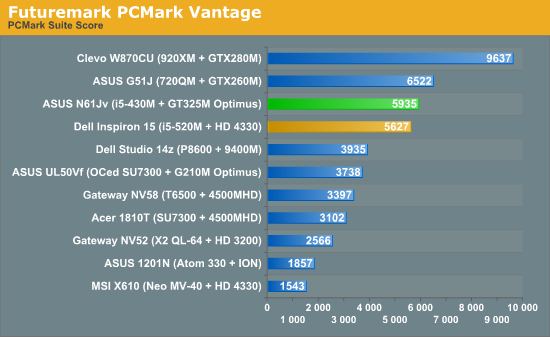

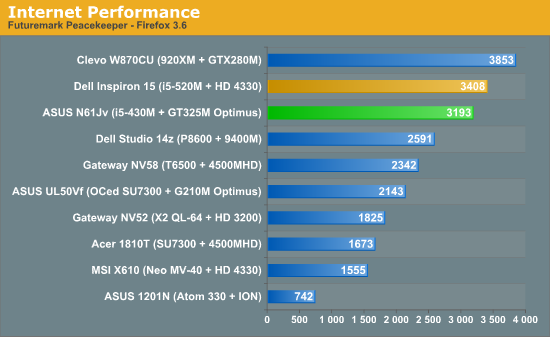
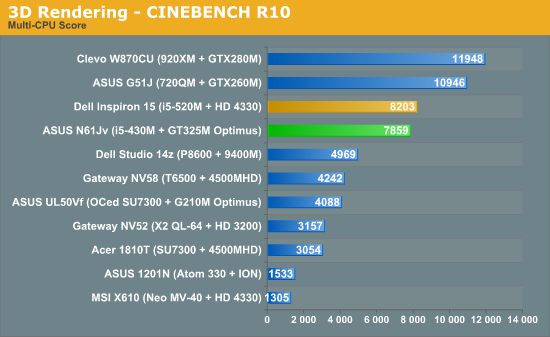
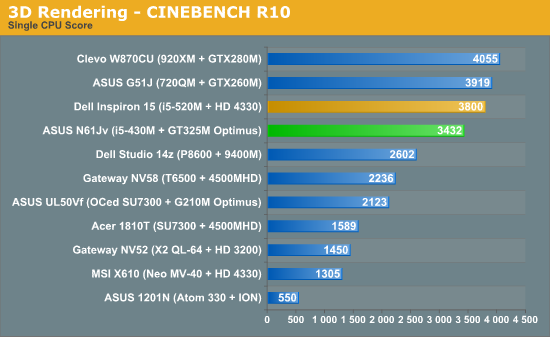

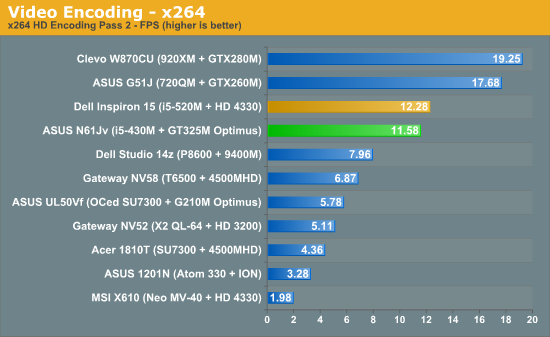
The results are great for a sub-$1000 notebook, trading blows with the Inspiron 1564 depending on whether the particular test benefits from a faster CPU or a faster GPU. PCMark05 doesn't benefit from faster graphics while PCMark Vantage does, which explains the swap in rankings. Peacekeeper also gives the i5-520M equipped Inspiron 15 a slight lead, along with x264 and Cinebench, but the gap is never more than 12%—exactly what we'd expect from the i5-430M vs. i5-520M matchup.
If you want something faster, you can see how the i7-720QM (ASUS G51J) and i7-920XM (Clevo W870CU) rank in terms of application performance. The W870CU also includes an Intel SSD, which dramatically boosts the PCMark scores (though the real-world impact is usually closer to a 10% performance increase). Obviously the i7-920XM isn't even in the same ballpark in terms of price, as the CPU alone will cost more than the N61Jv, but you can get notebooks with i7-720QM for around the same price as the N61Jv if you're willing to compromise on other areas (e.g. battery life).










44 Comments
View All Comments
avilella - Monday, March 22, 2010 - link
We are looking for students with basic Linux kernel/graphics notions interested in applying for the X.org Open Source PRIME multi-gpu support Google Summer of Code 2010:http://wiki.x.org/wiki/SummerOfCodeIdeas">http://wiki.x.org/wiki/SummerOfCodeIdeas
We are also looking for Linux users with Nvidia Optimus-enabled laptops willing to provide debugging information for Open Source PRIME multi-gpu support features being worked on. Please join the team by clicking on "Join" on the right, fill in this doodle:
http://www.doodle.com/63fyczzrxqaquhqx">http://www.doodle.com/63fyczzrxqaquhqx
and send an email to the mailing list specifying your laptop model with these commands:
sudo dmidecode -s system-product-name
sudo dmidecode -s system-version
lspci -vnnn | perl -lne 'print if /^\d+\:.+(\[\S+\:\S+\])/' | grep VGA
utkal - Monday, March 15, 2010 - link
I do not understand why the hell Asus only hosts 1366x768 resolution lcds in their laptops. They have ONLY ONE laptop of full HD upto 16" screen size with a price of $1440 (approx) ! wtf ! In a 16" laptop what can be worst than this resolution lcd.Sorry, but how AT reviewer said, we did not found anything bad about this laptop ? funny ! Do not you know the 1366x768 resolution makes the life hell if you use the laptop for work. Yes, if the laptop is bought ONLY TO GAME then its ok.
JarredWalton - Saturday, March 20, 2010 - link
RTFA. From the conclusion:"The worst aspect is the mediocre LCD panel, but when everyone uses lousy LCD panels (at least in sub-$1000 laptops and notebooks), we can only complain so much. The LCD panel and somewhat small battery capacity prevent us from giving the N61Jv our top Gold award...."
I've looked at dozens of laptops, and I've got a bunch more I'm working on reviewing. The ASUS Eee PC 1001P and the ASUS G73J are the ONLY laptops I have right now that don't have a similarly lousy LCD. Sure, you can get high-end laptops with good LCDs (Dell Precision M6500), but for consumer notebooks it's a lot harder than it should be.
jackwhitter - Monday, March 15, 2010 - link
"Today, we're reviewing our second Optimus notebook, but while the chassis isn't any smaller—in fact, it's slightly larger with a 16.0" LCD"it has a larger monitor with the same low resolution as a 11" monitor. why are companies so insistent to use such a low resolution on these larger screens? what happened to 1600x900?
JarredWalton - Monday, March 15, 2010 - link
One factor is cost and another is gaming performance. The GT325M will run most games at 1366x768 with Medium/High details at good frame rates. If the native LCD moved up to 1600x900, gaming performance would drop 37%. But the bigger issue is cost, I'm sure.utkal - Monday, March 15, 2010 - link
Dear, At least I do not think that people buys a laptop ONLY TO GAME. The primary purpose of laptop should not be gaming. And If you will work with applications like visual studio, you can hardly see few lines of code with a 1366x768 resolution where the vertical resolution will taken up by application titlebar, menubar, various toolbars, status bar and finally OS's taskbar !!! Now understand how difficult it to work with such low resolution laptop.No doubt other components are excellent with this price range, but they MUST have option for higher resolution screen, instead of making laptops for only GAMERS.
erple2 - Monday, March 15, 2010 - link
I'm sure that the only issue is cost. Many people will look at this computer at 900 dollars compared with 1200 for the one with higher resolution LCD and commensurate faster GPU and just buy the 900 dollar one.I would be more than happy to spend an additional fee for a better screen and faster discrete GPU (200-300 is about what I'd pay, I think, unless the GPU was _significantly_ faster, and/or the screen was _significantly_ higher quality/resolution).
jasperjones - Monday, March 15, 2010 - link
I refuse to buy products that don't have full Linux support. Linux support is much more important to me than a 10-15% difference in battery life.What happens if you try to install a recent Linux distro such as Ubuntu 9.10 on an Optimus laptop? Unfortunately, a quick Google search didn't provide any insights. (Btw, one of the top hits of my search was the launch article on Optimus here on Anandtech. There, Jarred asked virtually the same question.)
GeorgeH - Monday, March 15, 2010 - link
AFAIK an Optimus laptop should be considered a Win7 exclusive device, but confirmation would be nice; hopefully JW comes through.Quote from JW Feb 9:
"Some of you asked about Linux support ... at present, NVIDIA is focusing on Win7 ... we're not even sure what would happen if you try to install Linux ... we're going to quickly check and post the results."
http://www.anandtech.com/mobile/showdoc.aspx?i=373...">http://www.anandtech.com/mobile/showdoc.aspx?i=373...
Either we missed the promised update or our definitions of "quickly" are a little different. ;)
JarredWalton - Monday, March 15, 2010 - link
I did actually try Linux on the UL50Vf, but I neglected updating the article. Here's what I just put in there:I did actually test what happens with Optimus laptops and Linux. Even using an older 9.04 installation of Ubuntu, everything works as expected... which is to say, you can run Linux but you won't get the Optimus GPU. Since there's no direct connection of any display to the GPU, Optimus is required to move rendered content from the G210M to the GMA 4500MHD display buffer. As noted above, NVIDIA is currently focusing their efforts on making Optimus work on Windows 7; it's possible they will move to other OSes down the road, but they are not committed to doing so. If you want to run Linux and you want to use a discrete GPU, Optimus Technology won't work. Perhaps some skilled Linux community folks can figure out a way to do Optimus-like technology on their own, but given the level of detail required to interface with the GPU and IGP we see that as unlikely.
If you're one of the few people that want to run Linux and use a discrete GPU, then Optimus is definitely not going to make you happy. If all you want is to dual-boot Linux and you're okay with running it off the Intel IGP, you'll be fine.